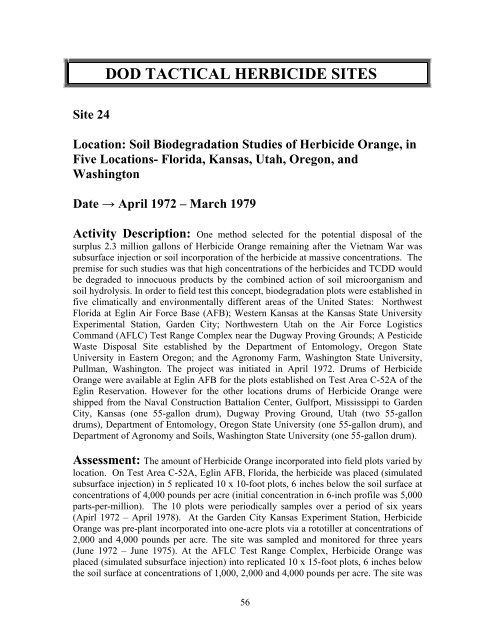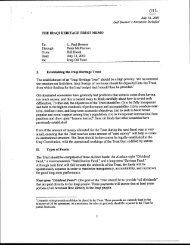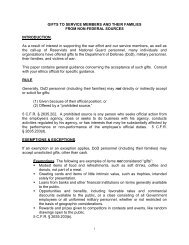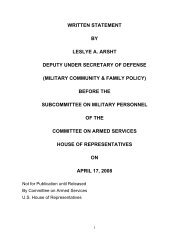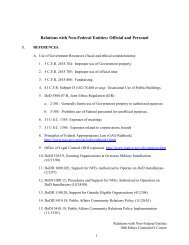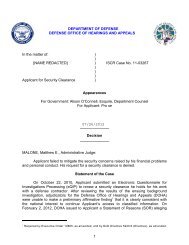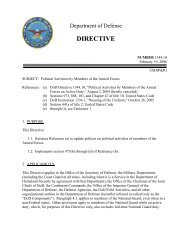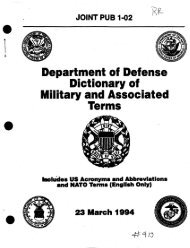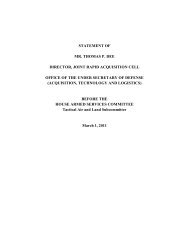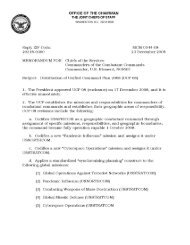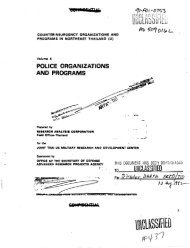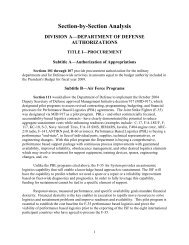dod tactical herbicide sites - United States Department of Defense
dod tactical herbicide sites - United States Department of Defense
dod tactical herbicide sites - United States Department of Defense
You also want an ePaper? Increase the reach of your titles
YUMPU automatically turns print PDFs into web optimized ePapers that Google loves.
DOD TACTICAL HERBICIDE SITESSite 24Location: Soil Biodegradation Studies <strong>of</strong> Herbicide Orange, inFive Locations- Florida, Kansas, Utah, Oregon, andWashingtonDate → April 1972 – March 1979Activity Description: One method selected for the potential disposal <strong>of</strong> thesurplus 2.3 million gallons <strong>of</strong> Herbicide Orange remaining after the Vietnam War wassubsurface injection or soil incorporation <strong>of</strong> the <strong>herbicide</strong> at massive concentrations. Thepremise for such studies was that high concentrations <strong>of</strong> the <strong>herbicide</strong>s and TCDD wouldbe degraded to innocuous products by the combined action <strong>of</strong> soil microorganism andsoil hydrolysis. In order to field test this concept, biodegradation plots were established infive climatically and environmentally different areas <strong>of</strong> the <strong>United</strong> <strong>States</strong>: NorthwestFlorida at Eglin Air Force Base (AFB); Western Kansas at the Kansas State UniversityExperimental Station, Garden City; Northwestern Utah on the Air Force LogisticsCommand (AFLC) Test Range Complex near the Dugway Proving Grounds; A PesticideWaste Disposal Site established by the <strong>Department</strong> <strong>of</strong> Entomology, Oregon StateUniversity in Eastern Oregon; and the Agronomy Farm, Washington State University,Pullman, Washington. The project was initiated in April 1972. Drums <strong>of</strong> HerbicideOrange were available at Eglin AFB for the plots established on Test Area C-52A <strong>of</strong> theEglin Reservation. However for the other locations drums <strong>of</strong> Herbicide Orange wereshipped from the Naval Construction Battalion Center, Gulfport, Mississippi to GardenCity, Kansas (one 55-gallon drum), Dugway Proving Ground, Utah (two 55-gallondrums), <strong>Department</strong> <strong>of</strong> Entomology, Oregon State University (one 55-gallon drum), and<strong>Department</strong> <strong>of</strong> Agronomy and Soils, Washington State University (one 55-gallon drum).Assessment: The amount <strong>of</strong> Herbicide Orange incorporated into field plots varied bylocation. On Test Area C-52A, Eglin AFB, Florida, the <strong>herbicide</strong> was placed (simulatedsubsurface injection) in 5 replicated 10 x 10-foot plots, 6 inches below the soil surface atconcentrations <strong>of</strong> 4,000 pounds per acre (initial concentration in 6-inch pr<strong>of</strong>ile was 5,000parts-per-million). The 10 plots were periodically samples over a period <strong>of</strong> six years(Apirl 1972 – April 1978). At the Garden City Kansas Experiment Station, HerbicideOrange was pre-plant incorporated into one-acre plots via a rototiller at concentrations <strong>of</strong>2,000 and 4,000 pounds per acre. The site was sampled and monitored for three years(June 1972 – June 1975). At the AFLC Test Range Complex, Herbicide Orange wasplaced (simulated subsurface injection) into replicated 10 x 15-foot plots, 6 inches belowthe soil surface at concentrations <strong>of</strong> 1,000, 2,000 and 4,000 pounds per acre. The site was56


